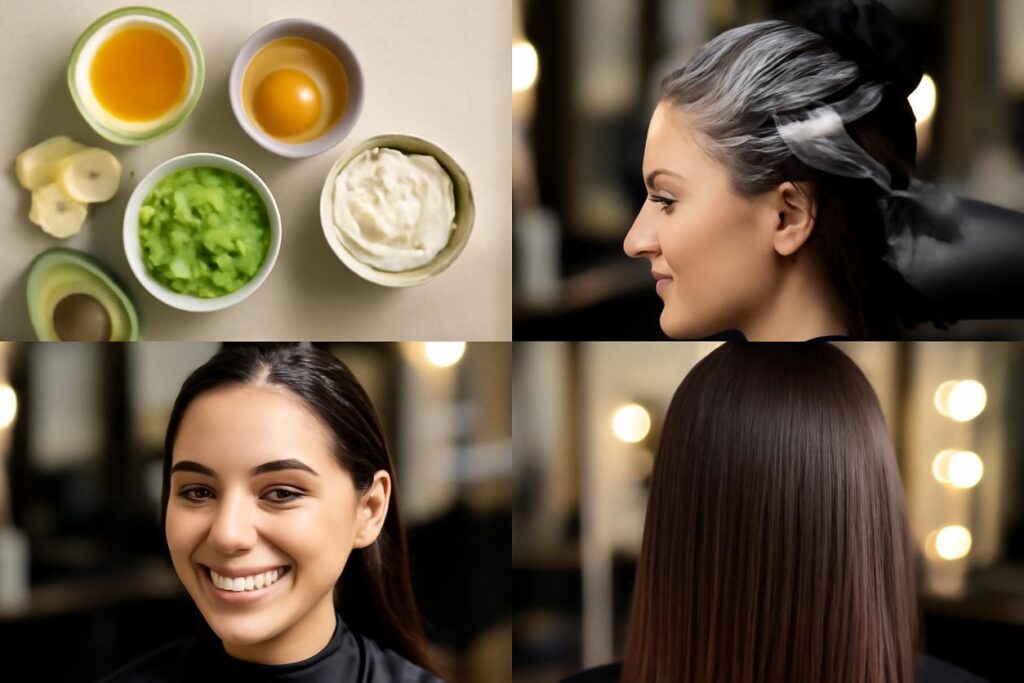Table of Contents
- Unlock Healthier Hair While You Sleep: An Introduction to Overnight Hair Care
- How Hair Repairs During Sleep: The Science Explained
- Assess Your Hair Type and Nightly Needs
- Core Overnight Routine Steps for Every Hair Type
- DIY Overnight Masks: Simple Recipes for Deep Nourishment
- Protective Night Styles and Techniques by Hair Type
- Choosing the Right Fabrics: Pillowcases, Wraps, and Turbans
- Overnight Product Ingredient Guide: What to Use and What to Avoid
- Morning Follow-Up: Gentle Wake-Up Routines to Lock in Benefits
- Your Bedtime Hair Plan for Measurable Improvement
- Troubleshooting Common Issues: Oiliness, Frizz, and Breakage
- FAQs: Quick Answers to Common Overnight Hair Care Questions
- Resources and Further Reading
Unlock Healthier Hair While You Sleep: An Introduction to Overnight Hair Care
What if you could transform your hair from dull and damaged to strong and shiny with minimal effort? It sounds too good to be true, but the secret might just lie in what you do before your head hits the pillow. Welcome to the world of overnight hair care, a revolutionary approach that uses your eight hours of sleep to actively repair, protect, and nourish your strands. For busy adults and beginners, creating an effective nighttime hair routine is the ultimate life hack for achieving your hair goals without sacrificing precious morning time.
Many of us focus our efforts on morning styling, but the night offers a unique, uninterrupted window for deep treatments and protection. While you rest, your body enters a state of regeneration. By adopting a few simple strategies, you can harness this natural process to combat frizz, prevent breakage, and wake up with hair that looks and feels healthier. This guide will walk you through the science, strategies, and simple steps to build a powerful overnight hair care routine tailored just for you.
How Hair Repairs During Sleep: The Science Explained
Your body does incredible things while you sleep, and your hair is a direct beneficiary. The concept of “beauty sleep” is rooted in real biological processes that are essential for hair health. Understanding this science is the first step to optimizing your nighttime routine.
During deep sleep, your body increases blood flow to the scalp, delivering more oxygen and essential nutrients to your hair follicles. This is the primary growth center for your hair. Simultaneously, your body’s production of stress hormones like cortisol decreases. Since high cortisol levels can contribute to hair shedding, quality sleep is a natural defense against stress-related hair loss. Furthermore, cell regeneration peaks at night, aiding in the repair of skin cells on the scalp and strengthening the follicles. This foundation of a healthy scalp is critical for growing strong, resilient hair. For more on the biological mechanisms at play, you can explore overnight hair care research and studies on cellular repair during sleep.
Assess Your Hair Type and Nightly Needs
Effective overnight hair care isn’t one-size-fits-all. Your hair’s unique texture and density determine its needs. Identifying your hair type is the key to choosing the right products, styles, and techniques that will work for you, not against you.
Understanding Your Hair’s Needs
Before you build your routine, take a moment to assess your hair. Is it fine and easily weighed down? Is it thick and prone to dryness? Answering these questions will guide your nightly strategy.
| Hair Type | Characteristics | Primary Overnight Goal |
|---|---|---|
| Straight | Lies flat from the root, prone to oiliness, can lack volume. | Prevent tangles and preserve volume. Avoid heavy products. |
| Wavy | Forms a gentle ‘S’ shape, can be prone to frizz. | Enhance natural wave pattern and control frizz. |
| Curly | Forms defined spirals or coils, prone to dryness and frizz. | Maintain moisture, protect curl pattern, and reduce frizz. |
| Coily | Forms tight coils or zig-zags, very prone to dryness and breakage. | Provide intense moisture and protect against breakage and shrinkage. |
Core Overnight Routine Steps for Every Hair Type
Regardless of your hair type, a successful overnight hair care routine is built on four fundamental pillars: cleansing correctly, protecting from damage, applying targeted treatments, and prioritizing quality sleep.
Step 1: Cleanse (or Don’t)
Deciding whether to wash your hair at night is a personal choice. If you do, ensure it’s at least 80-90% dry before bed. Sleeping on wet hair can make the hair cuticle more fragile and prone to breakage. For those with oily scalps, a gentle cleanse at night can remove the day’s buildup and allow the scalp to breathe.
Step 2: Protect
The primary goal of any nighttime routine is protection. This means minimizing friction from your pillowcase and preventing tangles. This is where protective styling and choosing the right fabrics come into play, which we’ll cover in detail below.
Step 3: Treat
Nighttime is the perfect opportunity for leave-in treatments to work their magic. Whether it’s a lightweight serum for fine hair or a rich butter for coily hair, applying a treatment product seals in moisture and delivers active ingredients over several hours. Focus the product on your mid-lengths and ends to avoid weighing down your roots.
Step 4: Sleep
Never underestimate the power of a good night’s rest. Your hair’s health is intrinsically linked to your overall well-being. Aim for 7-9 hours of quality sleep to allow your body the time it needs for repair and regeneration. For comprehensive guidance, see this advice on sleep and hair health guidance.
DIY Overnight Masks: Simple Recipes for Deep Nourishment
You don’t need expensive products to give your hair a nourishing boost. Your kitchen likely holds the ingredients for a simple, effective overnight mask. Apply your chosen mask to damp hair, cover with a shower cap and a bonnet, and rinse thoroughly in the morning.
- For Dry or Damaged Hair (Moisture Boost): Mix 2 tablespoons of aloe vera gel with 1 tablespoon of honey. Aloe vera is hydrating and rich in vitamins, while honey is a natural humectant that draws moisture into the hair shaft.
- For Frizzy or Curly Hair (Smoothing and Definition): Mash half a ripe avocado and mix with 1 tablespoon of olive or coconut oil. Avocado is packed with fatty acids and vitamins that smooth the hair cuticle and enhance shine.
- For Oily or Flaky Scalps (Soothing Treatment): Brew a strong cup of green tea and let it cool. Mix 3 tablespoons of the tea with a few drops of peppermint essential oil. Apply directly to the scalp to soothe inflammation and balance oil production.
Protective Night Styles and Techniques by Hair Type
How you wear your hair to bed is one of the most critical components of overnight hair care. The goal is to reduce friction and prevent knots without causing tension on your scalp.
For Straight and Wavy Hair
- The Loose Braid: A single, loose braid is perfect for preventing tangles. It can also create soft, heatless waves for the next day. Secure the end with a gentle tie, like a scrunchie.
- The Low, Loose Bun: Gather your hair at the nape of your neck and twist it into a loose bun. This keeps hair contained without creating a bump at the crown of your head.
For Curly Hair
- The Pineapple: This is a go-to for many curlies. Gather your hair into a very high, loose ponytail on top of your head. This protects your curl pattern and prevents it from getting crushed while you sleep.
- Multi-Pineapples or Mini Buns: For shorter hair, you can create two or more “pineapples” or small, loose buns to protect your curls.
For Coily Hair
- Twists or Braids: Sectioning the hair into several two-strand twists or braids is an excellent way to prevent tangles, minimize shrinkage, and lock in moisture.
- Banding: This method involves wrapping gentle hair ties down the length of a section of hair to stretch it and prevent shrinkage overnight.
Choosing the Right Fabrics: Pillowcases, Wraps, and Turbans
The surface your hair touches all night long matters. Traditional cotton pillowcases are highly absorbent, wicking moisture away from your hair and causing friction that leads to frizz and breakage.
The solution is to switch to a smoother fabric. Silk and satin are the gold standards for overnight hair protection. These materials allow your hair to glide across the surface, reducing friction and helping it retain its natural oils and moisture. You have several options:
- Silk or Satin Pillowcase: The easiest switch to make. It benefits both your hair and skin.
- Satin Bonnet or Cap: This is a fantastic option for containing all of your hair, especially for those with curly, coily, or voluminous styles. It ensures your protective style stays in place.
- Silk Scarf or Turban: A stylish and effective way to wrap your hair. This method offers a secure fit and fully protects your strands from the environment.
Overnight Product Ingredient Guide: What to Use and What to Avoid
When choosing products for your overnight hair care routine, reading the ingredient list is crucial. You want formulas that nourish and repair, not ones that cause buildup or dryness.
What to Look For
- Humectants: Ingredients like glycerin, hyaluronic acid, and aloe vera pull moisture from the air into your hair, keeping it hydrated.
- Emollients: Natural oils and butters such as shea butter, argan oil, and jojoba oil create a protective barrier to seal in moisture and smooth the hair cuticle.
- Proteins: Components like keratin and silk amino acids help fortify the hair shaft, repairing damage and improving elasticity. Use protein treatments in moderation to avoid stiffness.
What to Avoid
- Drying Alcohols: Short-chain alcohols like denatured alcohol or isopropyl alcohol can strip your hair of its natural moisture, leading to dryness and frizz.
- Heavy Silicones: While some silicones can be beneficial, heavy, non-water-soluble ones (like dimethicone) can build up over time, weighing hair down and preventing moisture from penetrating.
- Sulfates: These are typically found in shampoos and should not be in your leave-in overnight products, as they are harsh cleansing agents.
Morning Follow-Up: Gentle Wake-Up Routines to Lock in Benefits
Your morning routine should be quick and gentle to preserve the benefits of your hard work the night before. The goal is minimal manipulation.
- Gently Release Your Hair: Carefully undo your braid, bun, or twists. Use your fingers, not a brush, to separate the sections.
- Shake and Fluff: Flip your head over and gently shake your hair at the roots to restore volume. Use your fingertips to massage your scalp and position your hair.
- Refresh if Needed: If your hair needs a little pick-me-up, use a light mist of water or a curl-refreshing spray. You can also apply a tiny amount of oil or serum to the ends to add shine and tame any flyaways.
Your Bedtime Hair Plan for Measurable Improvement
Consistency is key to seeing real results from your overnight hair care routine. Follow this progressive plan starting in 2025 to build healthy habits and transform your hair.
| Timeframe | Action Plan | Goal |
|---|---|---|
| Days 1-7 | Commit to a protective style every night. Switch to a silk or satin pillowcase. | Establish the core habit of protection. Notice an immediate reduction in morning tangles and frizz. |
| Days 8-14 | Incorporate one DIY or store-bought overnight mask into your weekly routine. | Begin to deeply nourish your hair. Observe increased softness and shine. |
| Days 15-30 | Assess your progress. Refine your routine by trying a different protective style or treatment based on your hair’s response. | Solidify a personalized routine. See measurable improvement in hair strength, moisture retention, and overall health. |
Troubleshooting Common Issues: Oiliness, Frizz, and Breakage
Even with a great routine, you might face some challenges. Here’s how to tackle them.
- If your hair feels oily in the morning: You might be using a product that is too heavy or applying it too close to your roots. Focus treatments on the mid-lengths and ends. You can also try a light dusting of dry shampoo at the roots before bed to absorb excess oil.
- If you still have frizz: Ensure your hair is 100% dry before styling it for the night. Dampness can cause the cuticle to swell and create frizz. Also, check that your bonnet or scarf is secure throughout the night.
- If you notice breakage: Your protective style might be too tight. Braids, buns, and ponytails should be loose enough that you feel no tension on your scalp. Also, swap out harsh elastic ties for gentle scrunchies or spiral hair ties.
FAQs: Quick Answers to Common Overnight Hair Care Questions
Can I sleep with wet hair?
It’s best to avoid it. Hair is most fragile when wet, and the friction against your pillow can lead to breakage. Aim for your hair to be at least 80% dry before bed.
How often should I use an overnight mask or treatment?
This depends on your hair’s needs. For very dry or damaged hair, you might benefit from a mask 1-2 times per week. For normal or oily hair, once a week or every other week is sufficient.
Will an overnight hair care routine make my scalp greasy?
Not if done correctly. Avoid applying heavy oils, creams, or conditioners directly to your scalp. Focus all moisturizing products from the mid-lengths to the ends of your hair.
Resources and Further Reading
For a deeper dive into hair health, these resources offer valuable, evidence-based information:
- Scientific Research: Explore studies on hair biology and scalp health at the National Library of Medicine.
- Nutrition for Hair: Learn how your diet impacts hair health with this comprehensive hair nutrition overview.
- The Role of Sleep: Understand the connection between rest and overall well-being from the NHS sleep and tiredness guide.






